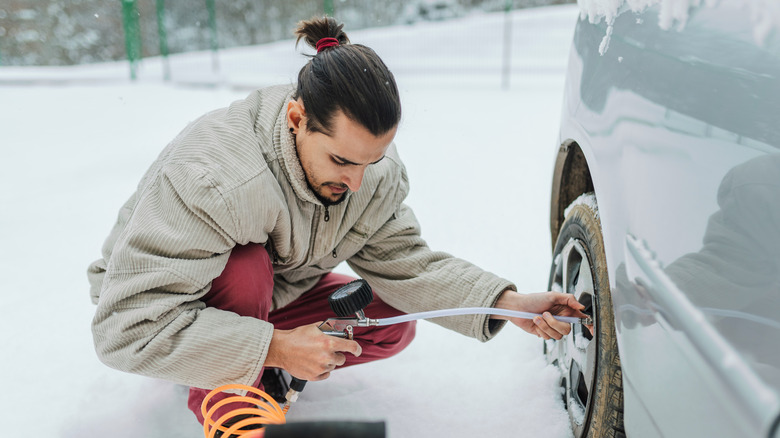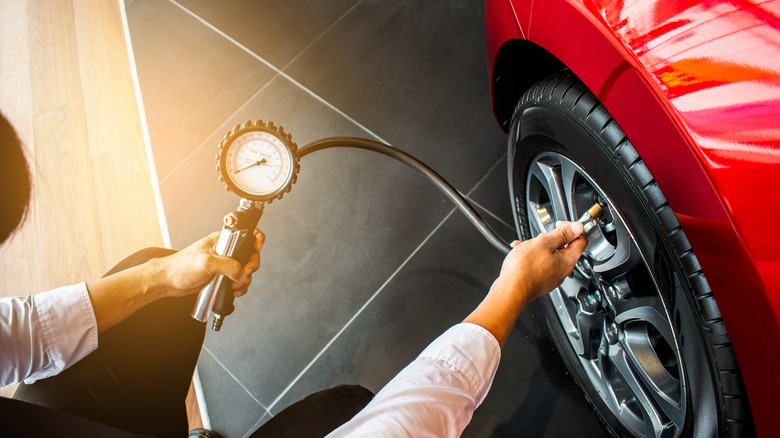How Often Should You Actually Check Your Car's Tire Pressure?
It's a common misconception among drivers that the only time to pay any attention to a car's tires is when one of them gets a flat. However, that is not the case, and the fact is that motorists should break their bad tire habits and keep an eye on their wheels on a regular basis. While it's wise to look out for nails and tears, the thing people should keep in mind is that tire pressure is the driving force behind tire longevity, which means checking it should be on every car owner's agenda. So, how often should consumers make the necessary effort?
While a person's tires may look full and ready to go every day, people should know that they experience a natural loss of air over time, and even if it isn't always noticeable, it could affect the vehicle and alter the pressure. It's also wise to remember that cold temperatures, especially those in the winter, cause tire pressure to fluctuate more than when it's hot in the summer.
To keep track of things, tire tester Ryan Pszczolkowski at Consumer Report explains people shouldn't wait for the corresponding warning light to illuminate on the dashboard. Further, even if their vehicle came equipped with a Tire Pressure Management System, they should be checking their tire pressure manually at the recommended amount, which is once a month. That doesn't mean just looking at one because consumers should have all four and the spare pressure assessed simultaneously. Fortunately, there are a few options available when it comes to the tool used to conduct the crucial maintenance task that makes it very easy to gauge the tire pressure.
Types of tire pressure gauges available
If people want to keep up with their self-appointed monthly inspections, they will need to arm themselves with a tire pressure gauge. The most reliable options available for purchase have a span that measures from 5 to 99 psi, so anything within those parameters would be a solid choice.
The most commonly used is the stick type, which is also generally the cheapest. Also referred to as the plunge or pencil type, it easily fits in the glove compartment or a pocket and looks like a ballpoint pen. If you are willing to spend a bit more, a dial gauge shows the reading more clearly thanks to a display that resembles a speedometer. It uses a needle to gather the reading and can come with additional features, but it is bigger than the stick version and requires more storage space. Last is the digital type, which has an LCD electronic screen, making it the easiest to read, but requires batteries to work, which the others don't.
After choosing the right one, it's always wise to maintain and secure the pressure measuring tool in order to ensure it lasts as long as possible. Any of the models described can be found at auto part stores like AutoZone, hardware shops like Home Depot, or even big box retail outlets like Walmart. Once a fitting gauge is secured, the process of checking the tire pressure once a month can commence, and it won't take long to witness the many benefits of keeping the wheels under pressure.
There are benefits to monitoring the tire pressure monthly
There are several upsides to practicing proper tire pressure checks, including a few advantages when it comes to saving money. Tires don't last as long if they aren't properly inflated, which leads to car owners being forced to shelve out big bucks for replacement tires. Beyond that, underinflated tires use more fuel for every mile traveled, leading to more frequent trips to the pump.
Tires also play a crucial role in an automobile's overall performance, and not keeping up with a car's tire pressure could adversely affect the car's handling or take a toll on the vehicle's responsiveness. The wheels are also kind of a big deal when it comes to stopping, so if they are not at the levels they should be, the brakes will potentially be impeded. Keeping up with the easy maintenance task and ensuring the proper amount of pressure is maintained can also reduce the chances of traffic accidents and prevent tire damage.
There is no denying that taking steps to ensure the wheels on the car continue to go round and round without any issues can be a rewarding experience, offering plenty of incentive for people to pressure themselves to check their tires every month.


